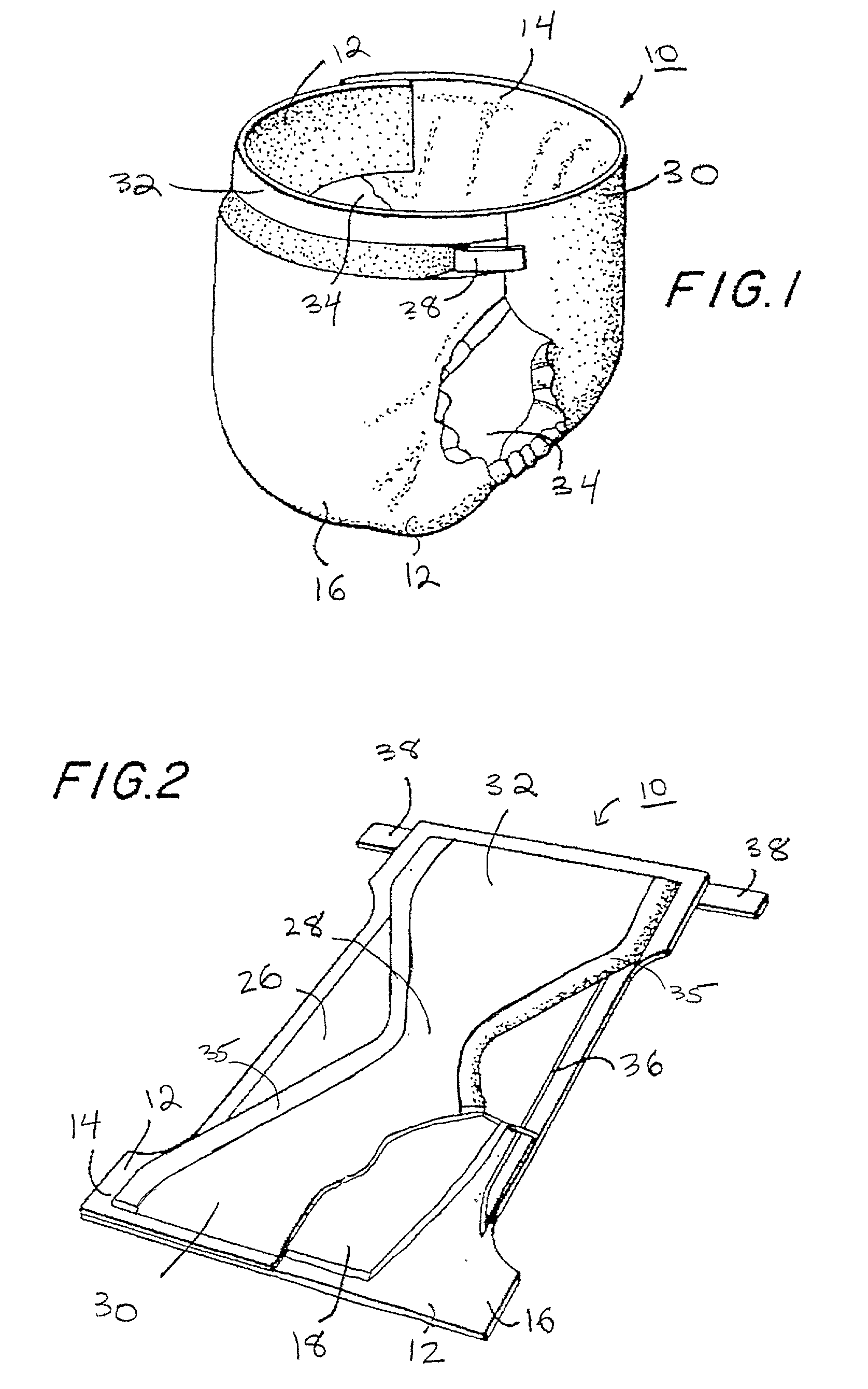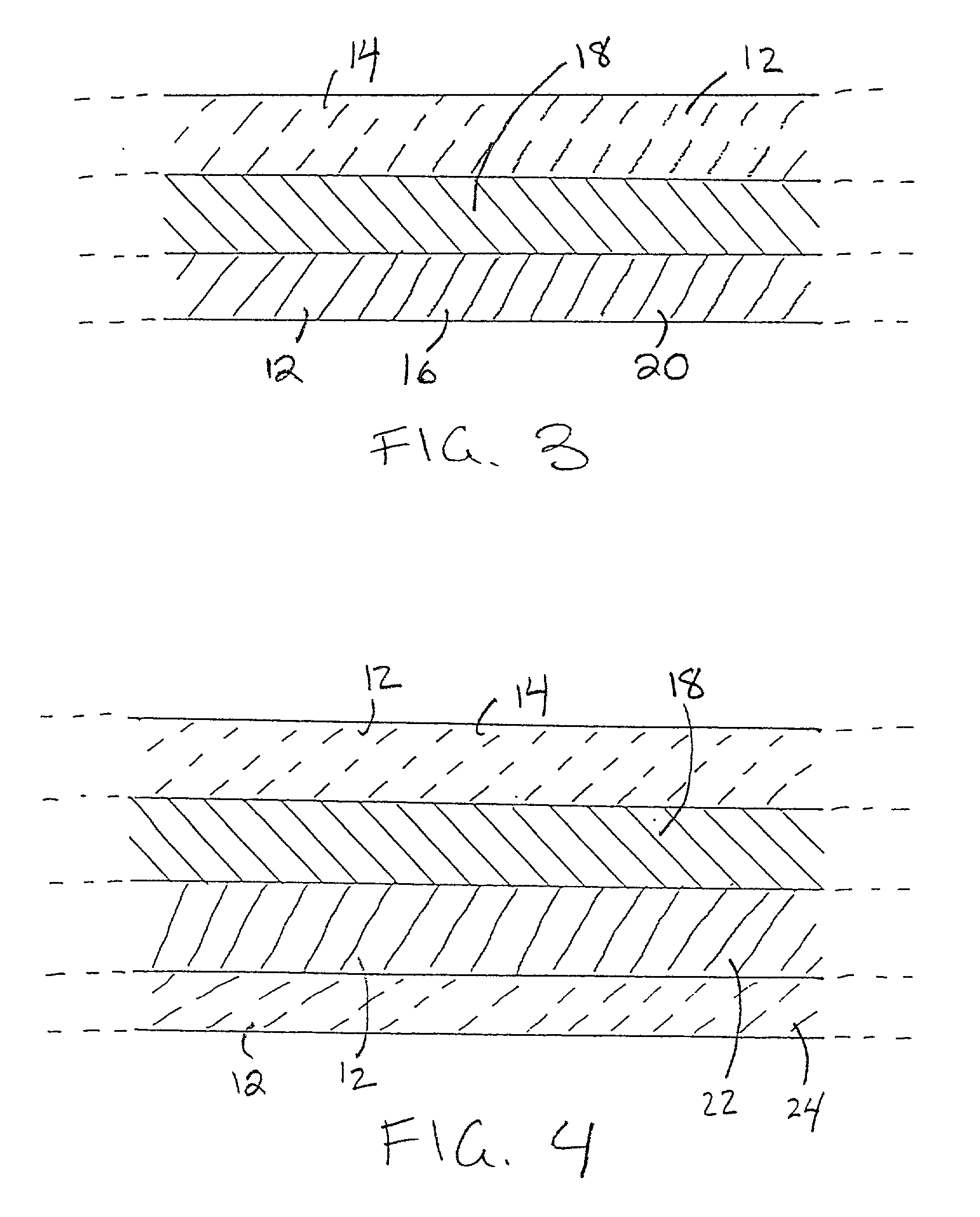Degradable disposable diaper
a disposable diaper and diaper technology, applied in the field of disposable diapers, can solve the problems of environmental safety hazards, disposable diapers have created new problems, and waste of plastic backsheet materials, and achieve the effects of low cost, high wet strength, and easy fabrication
- Summary
- Abstract
- Description
- Claims
- Application Information
AI Technical Summary
Benefits of technology
Problems solved by technology
Method used
Image
Examples
example 2
[0074] Fragmentation test
[0075] The time required for a non-woven polypropylene fabric to become brittle (break into fragments) was measured with and without prodegradant at different oven temperatures. The non-woven polypropylene fabric contained 98.5 wt. % polypropylene resin, 0.75 wt % polyethylene resin, 0.7275 wt. % calcium carbonate, and 0.0225 wt. % cobalt stearate.
[0076] These data are shown in Table 2. NF means no fragmentation.
2TABLE 2 % Additive 40.degree. C. 50.degree. C. 60.degree. C. 70.degree. C. 0 NF NF NF NF 1.5 NF 3 weeks 2 weeks 1 week
[0077] The increase in degradability in the presence of the additive as a function of increasing temperature is obvious.
example 3
[0078] Times required for fragmentation at different temperatures, using complete diapers in the tests, are shown in Table 3; the higher the temperature, the shorter the time required for embrittlement. The diapers included a polyethylene film that contained 98.5 wt % polyethylene, 1.44 wt % calcium carbonate, and 0.06 wt. % cobalt stearate and a polypropylene non-woven fabric that contained 98.5 wt. % polypropylene resin, 0.75 wt % polyethylene resin, 0.7275 wt. % calcium carbonate, and 0.0225 wt. % cobalt stearate.
3 TABLE 3 Time Temperature 3 days 70.degree. C. 1 week 60.degree. C. 22 days 43.degree. C.
example 4
[0079] This heatage study illustrates the shelf life and the selection of the appropriate type of packaging. The samples used were complete diapers in standard packaging. The diapers incorporated a polyethylene (PE) film that contained 98.5 wt % polyethylene, 1.44 wt % calcium carbonate, and 0.06 wt. % cobalt stearate and a non-woven polypropylene (PP) that contained 98.5 wt. % polypropylene resin, 0.75 wt % polyethylene resin, 0.7275 wt. % calcium carbonate, and 0.0225 wt. % cobalt stearate. One whole un-opened package of diapers was placed in heatage ovens with temperatures of 43, 54 and 71.degree. C. At approximately three weeks (actually 22 days) the packages were removed and inspected. The following are the observations made during the opening and inspection of the packages and diapers. The testing followed ASTM method D 5510.
[0080] After heating at 43.degree. C., the packaging appeared to be un-affected, and remained intact and sealed. The package was opened at the top as any ...
PUM
| Property | Measurement | Unit |
|---|---|---|
| particle size | aaaaa | aaaaa |
| weight % | aaaaa | aaaaa |
| weight % | aaaaa | aaaaa |
Abstract
Description
Claims
Application Information
 Login to View More
Login to View More - R&D
- Intellectual Property
- Life Sciences
- Materials
- Tech Scout
- Unparalleled Data Quality
- Higher Quality Content
- 60% Fewer Hallucinations
Browse by: Latest US Patents, China's latest patents, Technical Efficacy Thesaurus, Application Domain, Technology Topic, Popular Technical Reports.
© 2025 PatSnap. All rights reserved.Legal|Privacy policy|Modern Slavery Act Transparency Statement|Sitemap|About US| Contact US: help@patsnap.com


